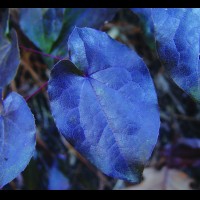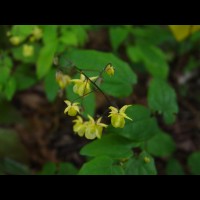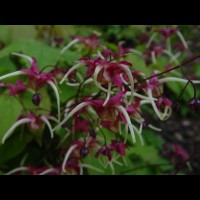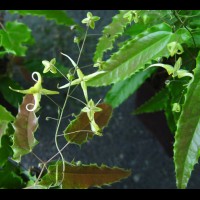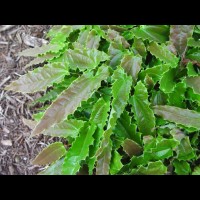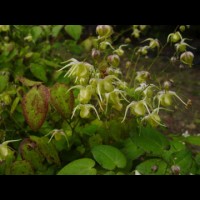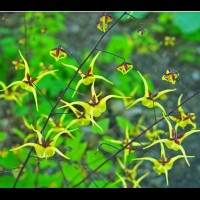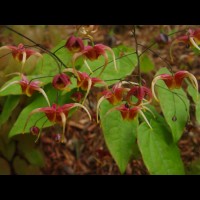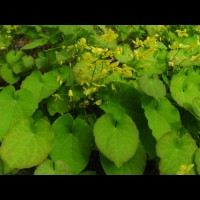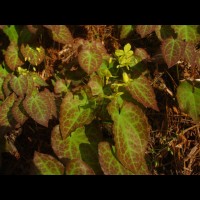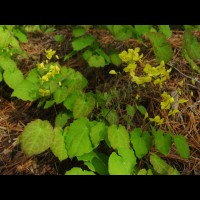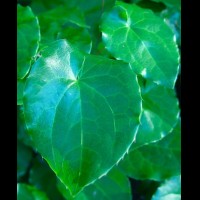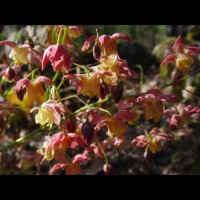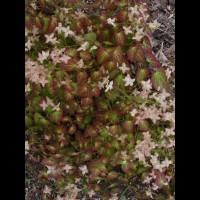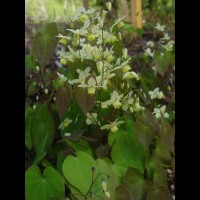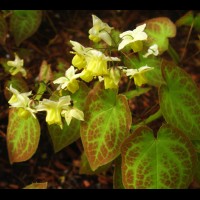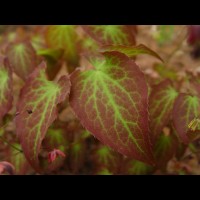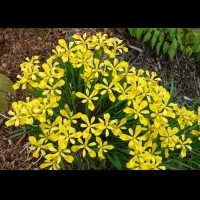Epimedium alpinum
Epimedium alpinum (Cc. 920002)
This drought tolerant spreading species from southern Europe sports very small flowers held below and among medium-sized leaflets. Inner-sepals are red behind creamy-yellow petals/spurs. 12" tall. The leaflets flaunt a complementary thin, mascara-like red edge while the plant is in bloom. Spreads 8-12" a year, forming an open groundcover. Semi-evergreen.
Epimedium davidii 'Emerald Sheen'
E. davidii ‘Emerald Sheen’ (Cc. 960085)
***2008 Cobblewood™ Introduction***
Extremely glossy leaflets are what makes this clone spectacular. It forms a mass of low growing, shiny foliage with smaller than normal, evergreen leaflets. The new spring foliage is tinted maroon. Flower stems are 12-24” tall with long spikes of many large, rich yellow flowers with tiny red inner-sepals. It is clump-forming, but produces occasional 3–5” rhizomes. Excellent for breeding, in that it passes the sheen of its foliage along to its offspring.
Epimedium davidii "Robust Forms"
E. davidii “Robust Form” (Several clones)
Like many species, E. davidii varies from one location to another. In 1999 Darrell helped to identify Epimediums purchased from China by a local nursery. Overall they were more robust and vigorous than any of the clones that he had collected in China, with flower stems from 18-24” high bearing the typical bright yellow blooms. They also had bolder evergreen foliage than any we have grown. The clones we offer have attractively red-mottled spring leaflets. Spreads slowly by occasional 4-8” rhizomes to form a mass 2’ wide in about 5 years under good growing conditions.
Epimedium grandiflorum 'French Braid'
E. grandiflorum ‘French Braid’ (Cc. 960042)
***2007 Cobblewood Introduction***
This eye-catching, vigorous, bold-foliaged seedling from Harold Epstein’s garden stands out from the pack with its bright, almost tropical spring leaf coloration. A psychedelic shade of orange flushes the edge of the leaflets that are dissected by luminous chartreuse veins flowing into an all green center. Large, elongated, overlapping leaflets tumble downward in a zig-zag pattern. Large creamy white flowers are borne underneath the expanding leaflets. 14” in bloom.
Epimedium grandiflorum 'Yellow Princess'
E. grandiflorum ‘Yellow Princess’ (Cc. 940547)
***2000 Cobblewood Introduction***
Simply beautiful, the small leaflets of this form a low 5-1/2” mass with large, clean, light yellow flowers held aloft on stems to 10”. The spent flower stems are eventually engulfed by a second growth flush. From high elevations in Japan, it emerges late and is one of the last of E. grandi
Epimedium grandiflorum f. flavescens #2
E. grandiflorum f. flavescens #2 (Cc. 940550)
Of the over 50 distinct clones of E. grandiflorum f. flavescens that Darrell brought back from Japan, this is by far the earliest to bloom with large, pale greenish-yellow flowers held below large, elliptical, bright apple green leaflets. Large, mature leaflets etched by the nearly parallel main veins make a bold, elegant garden statement. From the Kyoto Botanic Garden in Japan, it is very different from other clones circulating in the U.S. 20" tall. Clear yellow fall foliage. Spreads by 2-4" rhizomes.
Epimedium grandiflorum f. flavescens #3
Epimedium grandiflorum f. flavescens #3 (Cc. 950129)
Originally sold by Siskiyou Rare Plant Nursery under the invalid name E. macranthum ‘Aureum’. At 14”, it is shorter than most other E. grandiflorum f. flavescens clones offered here. Beautiful red-copper young leaflets unfurl over large, pale yellow flowers. After bloom, large, bold, oval-shaped leaflets expand to form an impressive mound. Clear yellow fall foliage color. Spreads by 2-4" rhizomes.
Epimedium grandiflorum f. flavescens #4
E. grandiflorum f. flavescens #4 (Cc. 960021)
Very different from other forms in commerce—almost like a straight E. grandiflorum. 20” tall, with 27 small leaflets per leaf, lightly bronze-tinted in spring. Large soft yellow flowers are held out from beneath the many small leaflets on long peduncles. Thin, wiry red stems arch out over the flowers, enhance the overall graceful textural nature of this clone.
Epimedium grandiflorum f. flavescens #5
E. grandiflorum f. flavescens #5 (Cc. 970232)
Reminiscent of E. koreanum ‘Harold Epstein’, with large soft yellow flowers and huge rounded leaflets, nearly as broad as long. However, its spreading rhizomes only grow 2-6” per year, forming a much thicker mass in the garden. Large, light yellow flowers held below the emerging foliage. 20” tall. Rusty red fall color.
Epimedium grandiflorum f . flavescens #6
Epimedium grandiflorum f. flavescens #6
Cc. 950188
Distinctive for the exaggerated extra points on each terminal leaflet. In spring, the large leaflets have a thin dark bronze edging with an overall light bronze blush. The smooth leaf surface and very delicate spring coloration creates a soft effect. Sizeable clusters of large, showy, pale yellow flowers are borne on long sprays beneath the leaves as they unfurl. 16” in bloom, to 20” tall. Spreads 2-4" per year.
Epimedium grandiflorum forma flavescens "Aomori Forms"
E. g. f. flavescens “Aomori Forms” (Several clones/Cc. #)
Prof. Stearn’s 1938 Epimedium monograph mentions “Faurie’s robust specimens from Aomori in Honshu, Japan”. Darrell explored the region in 1997. After several inquiries, their host led them to a steep hillside of densely planted Cryptomeria japonica, beneath which grew knee-high Epimediums with leaflets the size of your hand! Spring leaflets often flushed bronze-purple on 15-24” stems. Large, light yellow flowers open beneath the unfurling leaves. Rhizomes spread 2-4” a year, creating massive clumps over time.
Epimedium grandiflorum f. flavescens 'Chocolate Lace'
E. grandiflorum f. flavescens ‘Chocolate Lace’ (Cc. 980200)
***2003 Cobblewood Introduction***
Yummy, milk-chocolate tones on the emerging spring leaflets later melt into a rich burgundy tracing over a green backdrop with deep purple edges, before they mature to green. Large creamy, yellow-green flowers are held below the foli
Epimedium grandiflorum f. flavescens 'LaRocaille'
Epimedium grandiflorum f. flavescens ‘La Rocaille’ (Cc. 950040)
Originally offered in the 1970’s as E. grandiflorum f. flavescens by George Schenk of The Wild Garden, Bothel, WA. Plants established in Harold’s garden 25 years before grew into a large mass 6’ across. Its vigorous habit, long arrow-shaped leaflets and large, pale yellow flowers moved Harold to name it after his garden. Foliage is flushed a beautiful red in spring. 14” tall.
Epimedium grandiflorum var. coelestre 'Alpine Beauty'
E. grandiflorum var. coelestre ‘Alpine Beauty’ (Cc. 950058)
***2000 Cobblewood Introduction***
Extremely rare in the wild and in cultivation, this is the only Epimedium that grows at montaine heights. Beauti
Epimedium ilicifolium
Epimedium ilicifolium (Several clones/Cc. numbers)
A particularly cold-hardy, Chinese evergreen species from Shaanxi Province. Darrell found it in three areas in Nov. 2000 at the highest elevation above snowline. He trudged up steep ravines through snow and freezing temps just to see it in the wild. The long, narrow, evergreen leaflets are especially spiny (ilici-=holly, folium=leaf), on stems to 10”. Large flowers with light green inner sepals and bright yellow spurs, on stems to 18”.
Epimedium koreanum 'Harold Epstein'
Epimedium koreanum ‘Harold Epstein’ (Cc. 930004)
A very cold hardy clone with huge flowers for an Epimedium— gorgeous and butter yellow. Named in honor of Harold Epstein by plantsman Jerry Flintoff, its enormous leaflets can reach over 6” long and 4-1/2" wide. Spreads 6-12" a year. It usually takes 2-3 years to establish itself and become most impressive. The flowers emerge before the leaflets unfurl in early spring. E. koreanum is notorious for just putting up one set of leaves per node each season. If the leaf suffers damage, the rhizome will remain dormant until the following year. ‘Harold’ is a great bold-textured vigorous ground cover for large areas where it can spread unimpeded. It is especially useful in combination with early spring bulbs for sequential bloom. After bloom the expanding leaves serve as camouflage for the dying bulb foliage. 15" tall.
Epimedium lishihchenii
Epimedium lishihchenii (Several clones/Cc. numbers)
Collected by NACPEC in 1994 in Hubei Province, China, along with E. stellulatum. Produces large, bold evergreen leaflets that are heavy in substance. One of the few evergreen epimediums where the foliage makes it through many of our harsh winters. The large flowers have green inner-sepals and bright yellow spurs. Hardy to at least Zone 4. Grows to 12” tall. May exhibit various pastel shades in its spring foliage color. Fall color on some clones displays reddish markings on the leaves, as in accompanying photo.
Epimedium perralderianum
E. perralderianum (Cc. 980085)
Native to the moist remnants of oak and cedar forest in northeast Algeria, this drought tolerant species forms a handsome evergreen ground cover. Smaller than E. pinnatum ssp. colchicum, it differs in that its heart-shaped, veined leaflets are in sets of three, with spiny edges that give textural interest. Flowers are much the same-- small, lemon-yellow, and rounded with diminutive mahogany spurs that bend upwards. Leaflets are patterned with red/bronze in spring and fall. Spreading rhizomes grow 2-4". First foliage flush to 4", second to 8" high. This clone is courtesy of the late David Barker, who held one of the national UK collections of Epimediums.
Epimedium pinnatum ssp. colchicum
Epimedium pinnatum ssp. colchicum (Sev. clones/Cc. numbers)
Native to the mountainous areas of Georgia along the eastern coast of the Black Sea, this Epimedium is very drought tolerant. A workhorse groundcover for dry areas. Clusters of small, bright yellow flowers are produced on leafless stems above newly emerging leaves. Showy bright yellow inner-sepals back small petals that form a yellow cup. Short reddish spurs are held straight out against the inner-sepals. Spreads 6-8” a year creating a dense growth of large, rounded, shiny, deep evergreen leaflets on stems 8-10”.
Epimedium pinnatum ssp colchicum L321
Epimedium pinnatum ssp. colchicum L321 (Cc. 950222)
This Roy Lancaster collection was obtained from Robin White of Blackthorn Nursery. The dark evergreen leaflets are smaller and narrower than those of the other clones we grow, with a decorative wavy edge, making it a much more open plant, but one with a great deal of textural character. A favorite of mine. Otherwise, it is similar to the other clones. Spreads by 4-6" rhizomes. Drought tolerant.
Epimedium pinnatum ssp. colchicum 'Thunderbolt'
Epimedium pinnatum ssp. colchicum ‘Thunderbolt’ (Cc. 890003)
***2000 Cobblewood Introduction***
Collected in the former USSR Province of Georgia in 1973 by Skip March of the U.S. National Arboretum. We named this clone in cooperation with the Arboretum. Cool autumn temps turn the medium-sized, semi-glossy, evergreen leaflets either dark black/purple or a rich red mahogany, depending on the light exposure. An attractive “thunderbolt” pattern of green main veins overlays the fall color. Flowers have showy bright yellow inner-sepals. 10”. Spreads by rhizomes that grow 6-8” a year making this a great groundcover. Particularly drought tolerant.
Epimedium pinnatum ssp. pinnatum
E. pinnatum ssp. pinnatum (Cc. 980084)
This eastern subspecies of E. pinnatum is uncommon in cultivation. Native to the Caspian forests of northern Iran, the late David Barker shared this with us when we visited his garden in Chelmsford, Essex, UK in 1998. Sprays of small, bright lemon-yellow flowers with tiny brown spurs erupt in early spring to 7” beyond the newly emerging foliage. While the flowers are different from ssp. colchicum in having spurs that are half the length, gardeners will notice the difference in plant habit. Generally taller with 9 medium-sized evergreen leaflets per leaf vs. 3-5. Flowers 3/4” in diameter. Leaflets are a clear spring green with a slight rose flush. Spreads by 8” rhizomes. Light red fall color. The earliest of the E. pinnatums to leaf out in spring.
Epimedium platypetalum
Epimedium platypetalum (Several clones/Cc. numbers)
Native to China, 12 to 15” stems carry 10 to 20 dainty yellow bells suspended like tiny shuttlecocks, backed by tiny, white or reddish inner-sepals. The delicate blooms are held aloft on upright stems rising above small, rounded leaflets. Spreads by 8-12” long rhizomes, forming a low groundcover. Small, rounded, and slightly flecked new spring leaflets have few spines. While evergreen, the leaves flatten in the winter and are not very ornamental during that season. A particularly drought tolerant species.
Epimedium sempervirens 'Snowshoe Lake'
Epimedium sempervirens ‘Snowshoe Lake’ (Cc. 920033)
***2014 Cobblewood Introduction***
A white flowered very floriferous form of this extremely early bloomer. Sited in bright shade or a couple of hours of sun a day, it will produce clouds of clean white medium-sized flowers, 6” above the ground at the first thaw. Leaflets sport a delicate red line along their margins in early spring.
A cheerful and fitting tribute to my late brother George who lived on Snowshoe Lake in Alaska. 8-10” at maturity. An early bloomer.
Epimedium sp. nov. 'Simple Beauty'
E. sp. nov. ‘Simple Beauty’ (Cc. 022728)
***2010 Cobblewood Introduction***
A new, as yet unnamed, species collected by Darrell in China that is one of his most favorite. It is a simple leaved seedling/clone of a species new to science that normally has 3 leaflets... and VERY rare as Darrell only found a few of them. The very large and simple corrugated evergreen leaves are just about the glossiest of all Epimediums and can reach over 6” long and 2.5” wide. The new spring growth has a slight flush of red with thin needle-like spines along the margins. Flower stems extend 4-5” above the foliage supporting large flowers with long, sulphur-yellow spurs and light green inner-sepals. Its thick, spreading rhizomes grow from 2- 8" a year. It has proven to be a great parent. Photos courtesy of Mark McDonough.
Epimedium sp. nov. 'Spine Tingler'
Epimedium sp. nov. 'Spine Tingler' (Cc. 001764)
***2008 Cobblewood Introduction***
A form of an as yet, unnamed Chinese species collected by Darrell Probst in Sichuan Province. The long, narrow (1”) spiny leaflets emerge with a light chocolate wash in early spring. Later long, overarching stems of large lemon-yellow spidery flowers float over a mass of exceptional evergreen foliage. To 10".
5Epimedium sp. nov. 'Tarantula'
Epimedium sp. nov. ‘Tarantula’ Cc. 012418
This clone has the narrowest leaves of any Epimedium in our entire collection. Delicate hair-like spines, run the edge of each leaf in a zig-zag pattern. Bears long, sprays of soft yellow flowers. Leaflets range in size from .25 to 5/8” across, and 3-4” in length, sporting an occasional simple leaf.
Epimedium wushanense "Spiny leaved forms"
Epimedium wushanense "Spiny Leaved Forms" (Several clones/Cc. numbers)
A beautiful Epimedium with very large, glossy, evergreen leaflets with large spines. Leaflets have good substance and are each up to 6" long, resembling a wildly serrated knife. This extreme spininess of the leaves reveals the relationship of Epimediums to the Barberry family.
Unlike most Epimediums where the individual flowers are spaced so that you can differentiate each bloom, these have abbreviated, congested heads of flowers, reminiscent of a lilac or hydrangea panicle. The large flowers have white sepals and butter-yellow cup and spurs. Unlike the typical E. wushanense, these variants are lower, leafier, with shorter bloom panicles and spread by 4" rhizomes. Many exhibit a black-purple-reddish tinge to the new spring foliage. Plants can reach a height of 12-15" . Spreads slowly.
Epimedium 'Black Sea'
Epimedium ‘Black Sea’ (Cc. 960141)
Prized for its dark, glossy, near-black evergreen winter foliage whose color change is triggered by cool seasonal temperatures. Medium-sized leaflets on 8” stems form a thick groundcover. In spring 14” flower stems rise above the foliage carrying a myriad of small, diaphanous yellow flowers with pale orange veins. Semi-spreading, by 3-5” long rhizomes. An early bloomer, with foliage 12-14" high.
Epimedium 'Buttered Popcorn'
Epimedium ‘Buttered Popcorn’ (Cc. 960040)
***2001 Cobblewood Introduction***
This spontaneous hybrid between E. x setosum and E. davidi appeared in Harold Epstein’s garden in 1996. The plentiful, sunshine-yellow flowers bloom in long, thin sprays, just above the foliage to 15”. The charming small, yellow "box-shaped" flowers have a flared cup with short, sassy spurs and a red rim around the inner-sepals.
Small to medium-sized evergreen leaflets form a mass 10” tall. The leaflets are similar to those of E. davidii, but are longer and narrower, becoming dark green or even black-purple in winter. Grows more vigorously in northern gardens than E. davidii, producing a larger clump in less time.
Epimedium 'Flame Thrower'
Epimedium ‘Flame Thrower’ (Cc 990619)
***2009 Cobblewood Introduction***
Cheerful cherry red and creamy yellow flowers dance above the foliage of this hybrid from Darrell Probst. The inner sepals have decorative undulations to their shape, resembling flames licking upwards from the top of the flower. This cross between deciduous and evergreen parent plants gives this hybrid both vigorous growth and deep green, spiny leaflets of good substance. Drought-tolerant.
Epimedium 'Lemon Zest'
Epimedium ‘Lemon Zest’ (Cc. 990617)
***2005 Cobblewood Introduction***
From low, dense rosettes of small, shiny, rounded semi-evergreen leaflets flushed bronze in spring, emerge many erect racemes up to 12-15” high of cheerful, bright lemon-yellow bells. A slowly spreading hybrid which throws occasional rhizomes. A hybrid created by Darrell Probst. Foliage to 6". Flowers to 12".
Epimedium 'Ninja Stars'
Epimedium ‘Ninja Stars’ (Cc. 030301) Plant Patent #29744P2
***2016 Cobblewood Introduction***
A vigorous hybrid of two as yet unnamed, handsome species with particularly nice foliage collected in Sichuan Province, China by Darrell Probst. Long, narrow, very evergreen spiny leaflets form a crown of foliage 10-12” tall. Long sprays of spidery sulphur-yellow flowers scatter above the foliage. The multi-branched, spreading rhizomes grow 4-6” per year. New leaflets display a light bronzy-pink on first and second growth flushes in spring.
Epimedium 'Sunshowers'
Epimedium ‘Sunshowers’ (Cc. 050101)
***2008 Cobblewood Introduction***
This diminutive in bloom, but fast growing cultivar was created by friend Kelly Dodson of Far Reaches Farm. Cheerful, medium-sized light yellow flowers with straight, outfacing spurs are backed by short pink sepals. Numerous, erect flower panicles are held high above the foliage to 8”. Small spring leaflets are showered with red speckles. Re-blooms with secondary flushes of flecked growth to 12-14" for added appeal. This long blooming clone literally “rains” flowers. Semi-evergreen.
Epimedium 'Windfire'
Epimedium ‘Windfire’ (Cc. 002114)
**2007 Cobblewood Introduction***
Wiry, black-red upright flower spikes rise above the foliage carrying large, canary yellow flowers with small, dark red sepals. The thin reflexed spurs give the flower a very elegant silhouette. Slightly spreading with an open habit, by rhizomes that grow 4” a year. Medium-sized semi-evergreen leaflets form a leafy, open base to 12”. Flower spikes to 20”.
Epimedium 'Yokihi'
Epimedium ‘Yokihi’ (Cc. 050030)
An outstanding late-blooming Japanese cross between E. davidii and E. grandiflorum ‘Yubae’, this clumping hybrid produces long arching 18” spikes of large spidery flowers. The dramatic flowers have a flared creamy yellow cup and long, slender spurs backed by short, bright reddish pink inner sepals. Medium green angular leaflets are flushed with bronzy red in spring. Semi-evergreen.
Epimedium x omeiense 'Akame'
E. x omeiense ‘Akame’ Og. 82001 (Cc. 970187)
(Synonyms: ‘Emei Shan’, ‘Rigoletto’)
Mikinori Ogisu collected this clone on Mt. Emei in Sichuan, which Professor Stearn used as the type specimen for his description of E. x omeiense. The brilliant blooms have cherry-red inner-sepals and bright orange and yellow spurs. The cup is most intensely colored and edged in yellow. Open flower sprays are held above large, dark, handsome, glossy sagittate evergreen leaves that sometimes turn maroon in fall. 12-15” tall. A showy late bloomer.
Epimedium x perralchicum
Epimedium x perralchicum
(Several clones/Cc. numbers)
Long confused in the U.S. as its parent, E. perralderianum, (the other being E. pinnatum ssp. colchicum). The floral differences are minor, but the hybrid is more vigorous and hardier, to USDA Zone 4. Large, evergreen leaflets have slightly wavy margins. Like its parents, the leafless stems have small rich yellow flowers reminiscent of Verbascum. Spreads by 4-6” long rhizomes. Leaves form a thick mass 8-10” high. An excellent drought-tolerant groundcover that remains exceptionally evergreen through our harsh New England winters.
E. x perralchicum 'Frohnleiten'
E. x perralchicum ‘Fröhnleiten’ (Cc. 890005)
A drought-tolerant ground cover Epimedium prized for its colorful spring foliage, a gorgeous combination of reddish-bronze over the leaflet with an intricate pattern of green veins. Small, bright yellow flowers. Spreads 4-6” a year with medium/large evergreen leaflets that remain exceptionally evergreen through our harsh New England winters. 12” tall. Blends superbly with yellow-flowered late blooming Narcissus. One of the more common varieties available in the American market, and for good reason.
Epimedium x perralchicum 'Wisley'
Epimedium x perralchicum ‘Wisley’ (Cc. 960041)
A spontaneous hybrid discovered at the Royal Horticultural Society Garden at Wisley, England. Small, bright canary-yellow flowers are produced just above the newly emerging spring foliage to 10”. Medium to large leaflets are dark green with lighter veins and a delicate ruffled edge. The surface of each leaflet is shiny and "puffed" up between the veins, giving it a lustrous, faceted appearance that catches the light. Spreads by 4-6" rhizomes. A great drought-tolerant ground cover with exceptional evergreen leaflets that hold up through most of our harsh New England winters.
Epimedium x versicolor 'Cupreum'
Epimedium x versicolor ‘Cupreum’ (Cc. 950143)
Thanks to Carla Lankow of Renton, WA for the original stock of this captivating plant. With the same parents as ‘Versicolor’, it is similar, but has a slightly deeper flower color and more intensely red spring foliage with green venation. Usually with more numerous, slightly smaller leaflets per leaf, each more angular and less rounded. Foliage to 9” and flowers to 12”. Rhizomes grow 4-5” inches/year. Semi-evergreen with deep orange to maroon fall color. An early bloomer, it is also very drought-tolerant.
Epimedium x versicolor 'Neosulphureum'
E. x versicolor ‘Neosulphureum’ (Cc. 920044)
Undeservedly rare in cultivation, this counterpart to the more common ‘Sulphureum’ is shorter and semi-spreading with 2-4” rhizomes that form a tight groundcover. Pale yellow flowers are held on 12” erect, airy sprays. Flower spurs half as long as the inner-sepals. Spring leaflets are nicely bronzed on stems 6-8” and form a darker background against which to view the soft yellow flowers. Early bloomer and drought-tolerant. Semi-evergreen.
Epimedium x versicolor 'Strawberry Blush'
E. x versicolor ‘Strawberry Blush’ (Cc. 990615)
***2004 Cobblewood Introduction***
Wide, antique pink sepals brushed with rose streaks back a cheerful lemon-yellow cup, which deepens to rose purple short, curved spurs. The soft pastel flowers blend beautifully with the pinkish maroon mottled new spring leaflets. Darkest at the edges, the color fades to green at the center of small/medium-sized leaflets, before turning entirely green. Handsome, medium green, glossy summer/fall foliage. Particularly drought tolerant. Semi-evergreen. Flowers/foliage to 10”. Spreading rhizomes grow 2-4" per year. Drought-tolerant.
Epimedium xversicolor 'Sulphureum'
Epimedium xversicolor ‘Sulphureum’ (Cc. 840002)
(Synonym: E. pallidum)
Superb in mass plantings, it spreads 4-5” a year, forming a thick groundcover of leaves that holds its own against weeds. Bears long sprays of pale yellow flowers with spurs nearly equal in length to the inner-sepals are produced above leaflets flushed red in spring. 10" tall in bloom. Semi-evergreen leaves. Drought-tolerant.
Epimedium x versicolor 'Versicolor'
E. versicolor x ‘Versicolor’ (Cc. 890006)
(syn. E. x versicolor 'Discolor')
Quite rare in gardens, this has long been one of our favorite clones. Delicate flowers open a deep, rich pink-salmon, and fade over the course of several days. Large panicles of flowers hover above leaflets strongly flushed with red in spring. It spreads 4 to 5" a year forming a gorgeous mass of riotous color in spring. 14" tall. Early bloomer and drought-tolerant. Very similar to E. x versicolor 'Cupreum' in appearance and habit. Semi-evergreen.
Iris koreana 'Firefly Shuffle'
Iris koreana ‘Firefly Shuffle’
***2010 Cobblewood Introduction***
A very floriferous clone of this Asian species iris, and a good grower. Mid May is heralded with the annual explosion of sunny, bright lemon yellow blossoms covering the plant. Great for the rock garden. Best in bright shade or a few hours of direct sun, it forms a grassy-leaved clump that slowly spreads into a “patch”. Semi-evergreen.
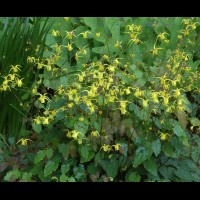
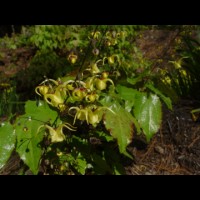

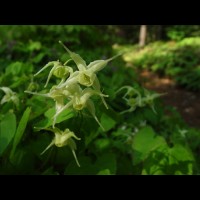

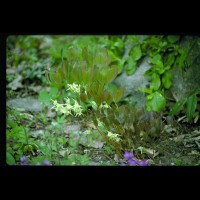
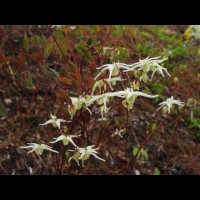
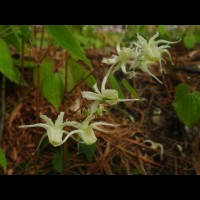
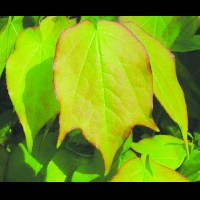
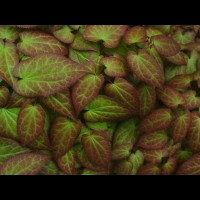

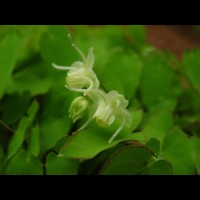
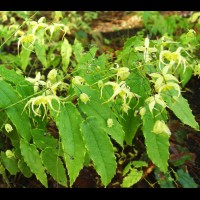

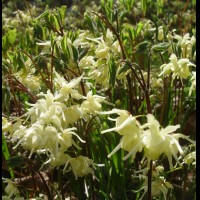
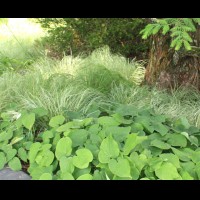
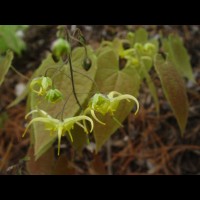
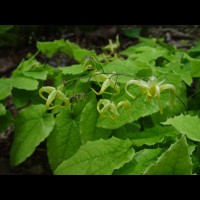
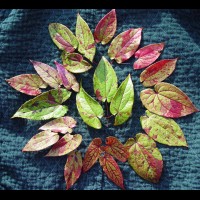
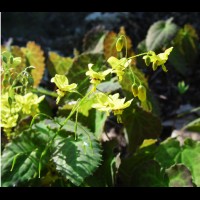
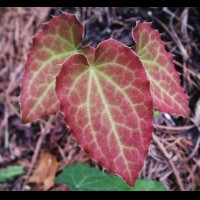
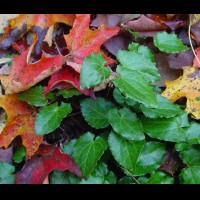
.jpg)
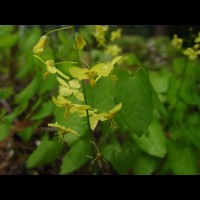
.jpg)
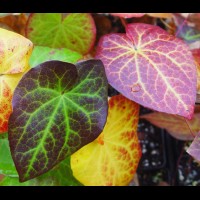
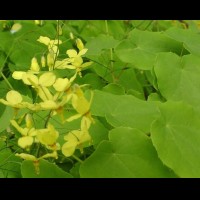
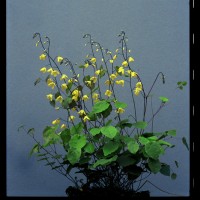
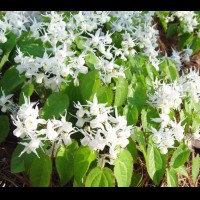
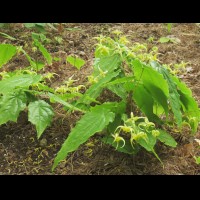
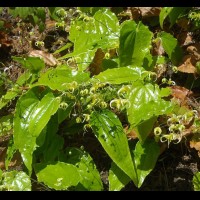
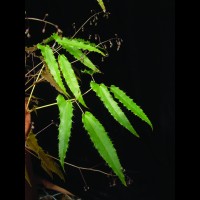
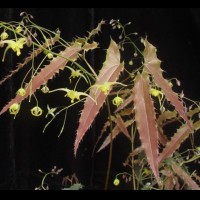
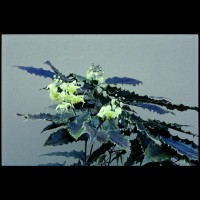
.jpg)
